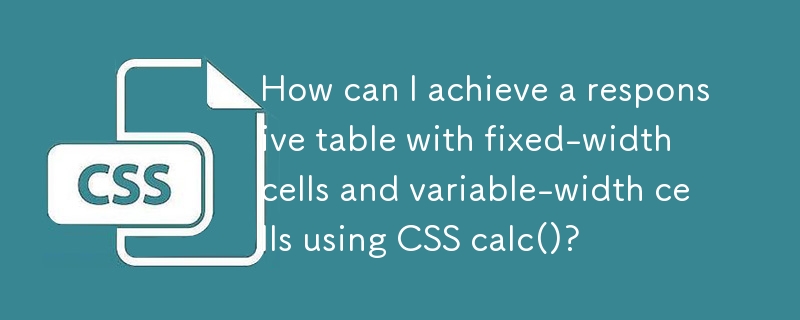 Web Front-end
Web Front-end
 CSS Tutorial
CSS Tutorial
 How can I achieve a responsive table with fixed-width cells and variable-width cells using CSS calc()?
How can I achieve a responsive table with fixed-width cells and variable-width cells using CSS calc()?
How can I achieve a responsive table with fixed-width cells and variable-width cells using CSS calc()?

Styling Tables with calc() and Fixed-Width Cells
In web development, tables are often used to organize data, but it can be challenging to set specific widths for columns while maintaining flexibility for variable-content cells. This is where the CSS calc() function can come in handy.
Consider the scenario where you want a table with fixed-width cells for specific columns, such as the first and last columns, but you also want the remaining cells to be variable-width and adapt to their content. Using calc(), you can specify the width of these variable-width cells as a percentage of the remaining space in the table.
However, in the provided code snippet, you may encounter difficulties using calc() within a table. This is because tables have specific rules for distributing space to columns, prioritizing the contents of the cells.
To solve this problem and achieve your desired layout, you can use the following approach:
- Set table-layout: fixed; on the table: This forces the table's child td elements to adhere to the widths you specify, ensuring that the fixed-width cells remain at their specified dimensions.
- Ensure the table has a fixed width (100% in this case): A defined width is crucial for table-layout: fixed; to work properly.
- Use percentages for the remaining columns: After accounting for the fixed-width columns, you can assign relative widths to the remaining columns using percentages. For example, if you want these columns to occupy 40%, 40%, and 20% of the remaining space, you would set their widths as 40%, 40%, and 20%, respectively.
By following these steps, you can take advantage of calc() to achieve a table with fixed-width cells and variable-width cells that behave as intended, adapting to their content while ensuring the integrity of the fixed-width columns.
The above is the detailed content of How can I achieve a responsive table with fixed-width cells and variable-width cells using CSS calc()?. For more information, please follow other related articles on the PHP Chinese website!

Hot AI Tools

Undresser.AI Undress
AI-powered app for creating realistic nude photos

AI Clothes Remover
Online AI tool for removing clothes from photos.

Undress AI Tool
Undress images for free

Clothoff.io
AI clothes remover

AI Hentai Generator
Generate AI Hentai for free.

Hot Article

Hot Tools

Notepad++7.3.1
Easy-to-use and free code editor

SublimeText3 Chinese version
Chinese version, very easy to use

Zend Studio 13.0.1
Powerful PHP integrated development environment

Dreamweaver CS6
Visual web development tools

SublimeText3 Mac version
God-level code editing software (SublimeText3)

Hot Topics
 1377
1377
 52
52
 Working With GraphQL Caching
Mar 19, 2025 am 09:36 AM
Working With GraphQL Caching
Mar 19, 2025 am 09:36 AM
If you’ve recently started working with GraphQL, or reviewed its pros and cons, you’ve no doubt heard things like “GraphQL doesn’t support caching” or
 Making Your First Custom Svelte Transition
Mar 15, 2025 am 11:08 AM
Making Your First Custom Svelte Transition
Mar 15, 2025 am 11:08 AM
The Svelte transition API provides a way to animate components when they enter or leave the document, including custom Svelte transitions.
 Show, Don't Tell
Mar 16, 2025 am 11:49 AM
Show, Don't Tell
Mar 16, 2025 am 11:49 AM
How much time do you spend designing the content presentation for your websites? When you write a new blog post or create a new page, are you thinking about
 Building an Ethereum app using Redwood.js and Fauna
Mar 28, 2025 am 09:18 AM
Building an Ethereum app using Redwood.js and Fauna
Mar 28, 2025 am 09:18 AM
With the recent climb of Bitcoin’s price over 20k $USD, and to it recently breaking 30k, I thought it’s worth taking a deep dive back into creating Ethereum
 What the Heck Are npm Commands?
Mar 15, 2025 am 11:36 AM
What the Heck Are npm Commands?
Mar 15, 2025 am 11:36 AM
npm commands run various tasks for you, either as a one-off or a continuously running process for things like starting a server or compiling code.
 How do you use CSS to create text effects, such as text shadows and gradients?
Mar 14, 2025 am 11:10 AM
How do you use CSS to create text effects, such as text shadows and gradients?
Mar 14, 2025 am 11:10 AM
The article discusses using CSS for text effects like shadows and gradients, optimizing them for performance, and enhancing user experience. It also lists resources for beginners.(159 characters)
 Creating Your Own Bragdoc With Eleventy
Mar 18, 2025 am 11:23 AM
Creating Your Own Bragdoc With Eleventy
Mar 18, 2025 am 11:23 AM
No matter what stage you’re at as a developer, the tasks we complete—whether big or small—make a huge impact in our personal and professional growth.
 Let's use (X, X, X, X) for talking about specificity
Mar 24, 2025 am 10:37 AM
Let's use (X, X, X, X) for talking about specificity
Mar 24, 2025 am 10:37 AM
I was just chatting with Eric Meyer the other day and I remembered an Eric Meyer story from my formative years. I wrote a blog post about CSS specificity, and



